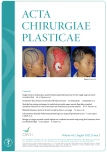Záchrana obnaženého lebečního implantátu v terénu ozářené nekrotizované kůže hlavy pomocí volného laloku latissimus dorsi a čelního laloku – kazuistika
Autoři:
Taliat G.; Kumar M. K.; Shivalingappa S.
Působiště autorů:
Department of Plastic Surgery, M S Ramaiah Medical College Hospital, MSRIT nagar, Bangalore, India
Vyšlo v časopise:
ACTA CHIRURGIAE PLASTICAE, 64, 2, 2022, pp. 89-92
doi:
https://doi.org/10.48095/ccachp202289
Zdroje
1. Sahuquillo J., Arikan F. Decompressive craniectomy for the treatment of refractory high intracranial pressure in traumatic brain injury. Cochrane Database Syst Rev. 2006; 1: CD003983.
2. Aydin S., Kucukyuruk B., Abuzayed B., et al. Cranioplasty: review of materials and techniques. J Neurosci Rural Pract. 2011, 2(2): 162–167.
3. Di Rienzo A., Pangrazi PP., Riccio M., et al. Skin flap complications after decompressive craniectomy and cranioplasty: proposal of classification and treatment options. Surg Neurol Int. 2016, 7 (Suppl 28): S737–S745.
4. Haubner F., Ohmann E., Pohl F., et al. Wound healing after radiation therapy: review of the literature. Radiat Oncol. 2012, 7(1): 162.
5. Hwang SO., Chang LS. Salvage of an exposed cranial prosthetic implant using a transposition flap with an indwelling antibiotic irrigation system. Arch Craniofac Surg. 2020, 21(1): 73–76.
6. Kurland DB., Khaladj-Ghom A., Stokum JA., et al. Complications associated with decompressive craniectomy: a systematic review. Neurocrit Care 2015, 23(2): 292–304.
7. Martin RM., Zimmermann LL., Huynh M., et al. Diagnostic approach to health care- and device-associated central nervous system infections. J Clin Microbiol. 2018, 56(11): e00861–18.
8. Marks JE., Freeman RB., Lee F., et al. Pharyngeal wall cancer: an analysis of treatment results complications and patterns of failure. Int J Radiat Oncol Biol Phys. 1978, 4(7–8): 587–593.
9. Gristina AG., Hobgood CD., Webb LX., et al. Adhesive colonization of biomaterials and antibiotic resistance. Biomaterials 1987, 8(6): 423–426.
10. Gosain A,, Chang N,, Mathes S., et al. A study of the relationship between blood flow and bacterial inoculation in musculocutaneous and fasciocutaneous flaps. Plast Reconstr Surg. 1990, 86(6): 1152–1162.
11. Tan O., Cinal H., Algan S., et al. Reconstruction of the wide scalp defects using free latissimus dorsi flap assisted with arteriovenous loop. J Craniofac Surg. 2015, 26(7): 2220–2221.
12. Mikami T., Miyata K., Komatsu K., et al. Exposure of titanium implants after cranioplasty: a matter of long-term consequences. Interdiscip Neurosurg. 2017, 8: 64–67.
Štítky
Chirurgie plastická Ortopedie Popáleninová medicína TraumatologieČlánek vyšel v časopise
Acta chirurgiae plasticae

2022 Číslo 2
- Metamizol jako analgetikum první volby: kdy, pro koho, jak a proč?
- MUDr. Lenka Klimešová: Multioborová vizita může být klíčem k efektivnější perioperační léčbě chronické bolesti
- Léčba akutní pooperační bolesti z pohledu ortopeda
- Příčiny a možnosti ovlivnění bolesti předního kolene po implantaci totální endoprotézy
Nejčtenější v tomto čísle
- Endoskopicky asistovaný odběr temporoparietální fascie z jedné incize pro jednodobou rekonstrukci boltce
- Záchrana obnaženého lebečního implantátu v terénu ozářené nekrotizované kůže hlavy pomocí volného laloku latissimus dorsi a čelního laloku – kazuistika
- Hook nail treatment – a bulky palmar flap as an alternative to the “antenna” procedure and to the thenar flap for fingertip coverage
- Oboustranný latissimus dorsi lalok v jednodobé rekonstrukci prsu
